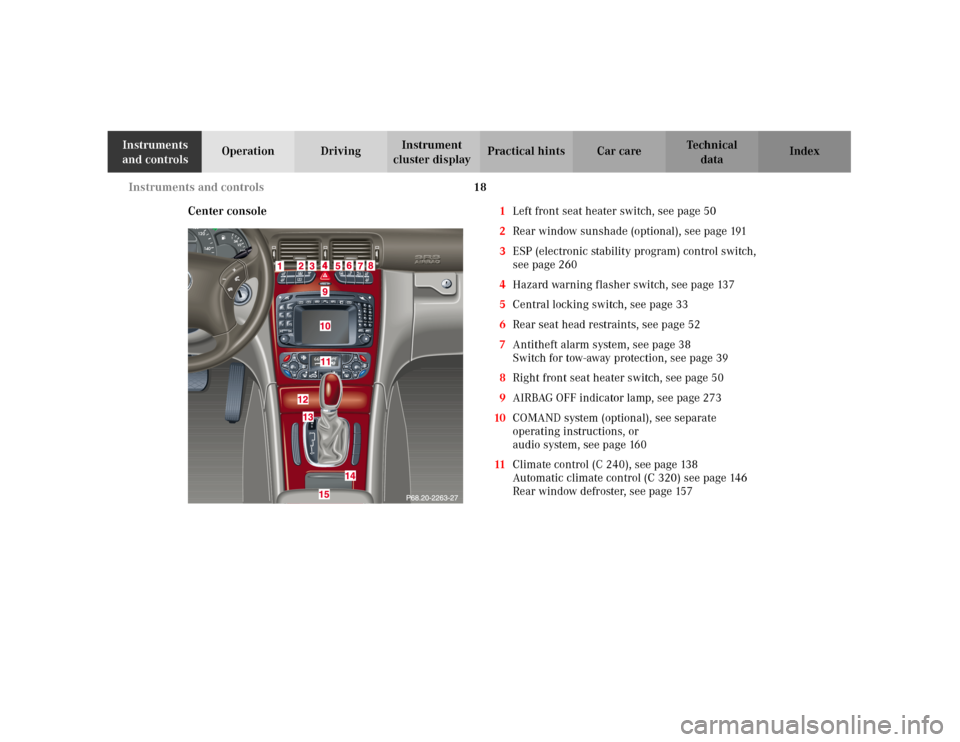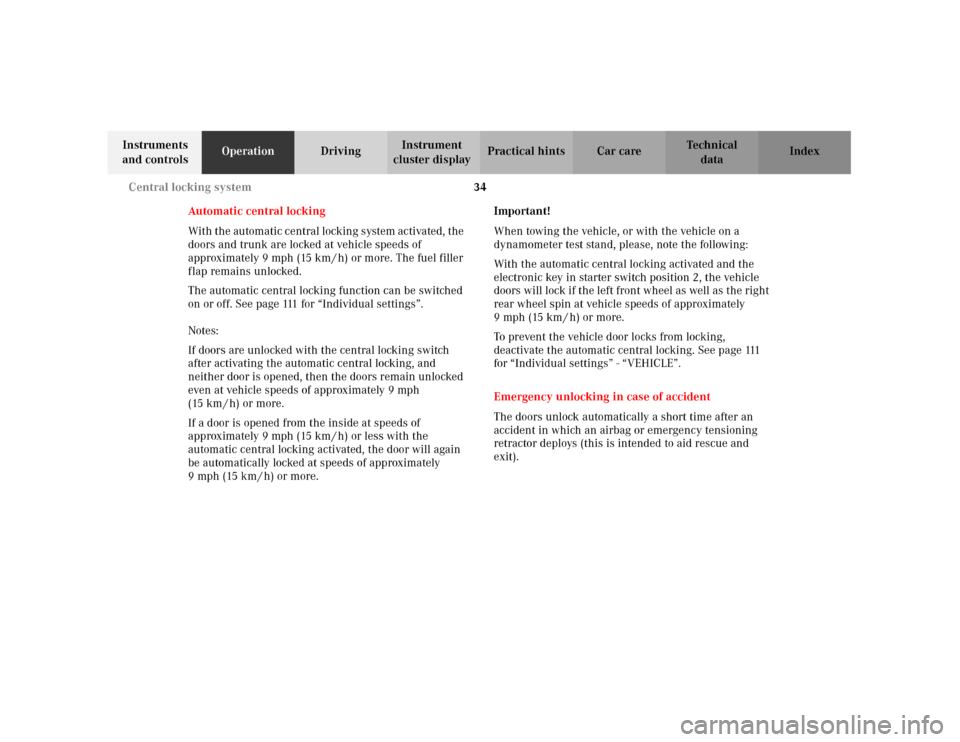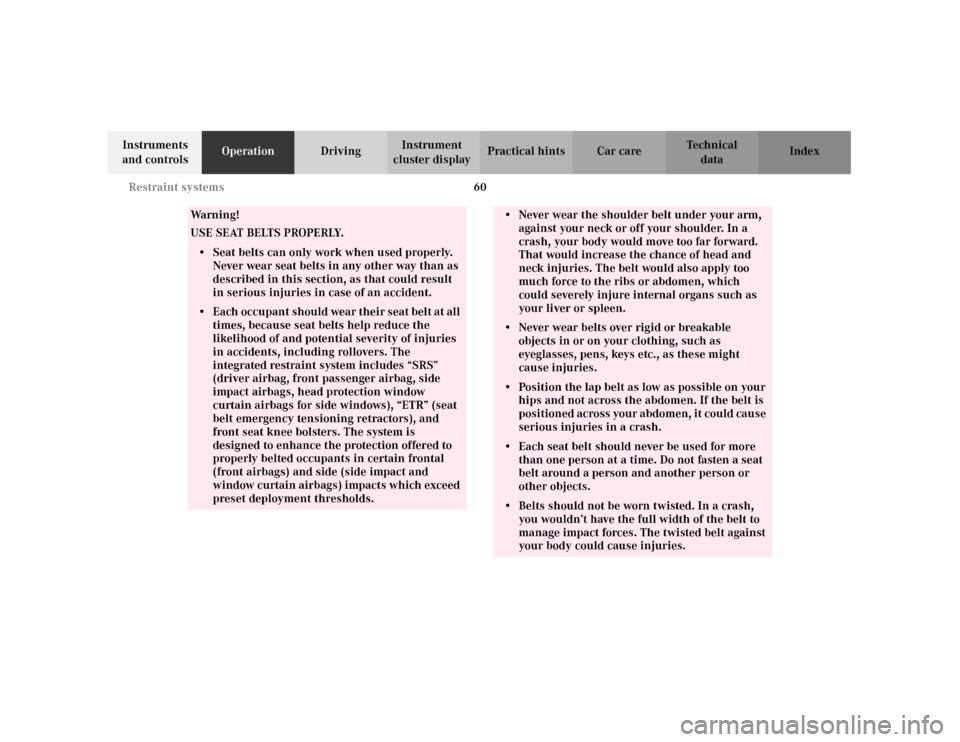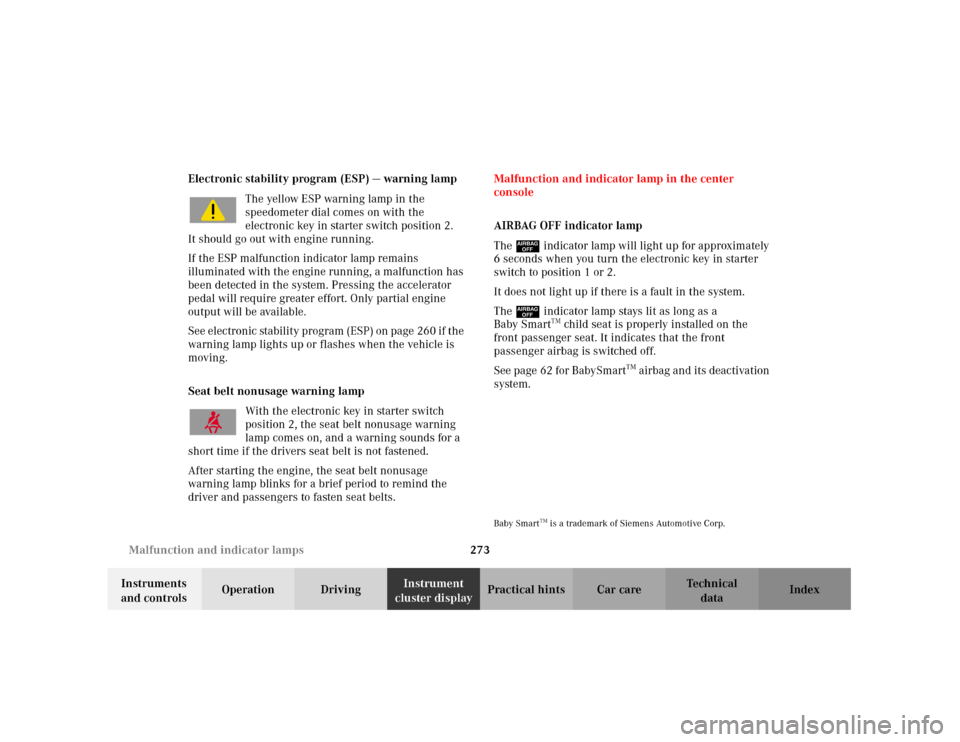2001 MERCEDES-BENZ C240 airbag off
[x] Cancel search: airbag offPage 6 of 381

Contents
DrivingControl and operation of radio
transmitters ............................... 218
The first 1 000 miles
(1 500 km) ................................. 219
Maintenance ................................... 219
Tele Aid ...........................................220
Catalytic converter ........................228
Emission control ............................229
Starter switch .................................230
Starting and turning
off the engine ............................232
Manual transmission ....................233
Automatic transmission ...............234
Parking brake .................................243
Driving instructions ......................244
Drive sensibly – Save Fuel ........244
Drinking and driving .................244
Pedals ...........................................244Power assistance ........................ 245
Brakes .......................................... 245
Driving off ................................... 246
Parking ........................................ 246
Tires ............................................. 247
Snow chains ............................... 250
Winter driving
instructions ................................ 250
Deep water .................................. 252
Passenger compartment ........... 253
Traveling abroad ........................ 253
Cruise control ................................ 254
Brake assist system (BAS) ............ 257
Antilock brake system
(ABS) .......................................... 258
Electronic stability program
(ESP) ........................................... 260
What you should know at the gas
station ......................................... 264
Check regularly and before a long
trip .............................................. 266
Instrument cluster displayMalfunction and indicator lamps in
the instrument cluster .............268
On-board diagnostic system .........268
Check engine malfunction
indicator lamp .............................268
Brake warning lamp ..................270
Supplemental restraint system
(SRS) indicator lamp .................. 271
Fuel reserve warning ................. 271
ABS malfunction
indicator lamp .............................272
Electronic stability program
(ESP) — warning lamp ...............273
Seat belt nonusage
warning lamp ............................273
Malfunction and indicator lamp in
the center console .....................273
AIRBAG OFF indicator lamp .....273
Page 27 of 381

18 Instruments and controls
Te ch n i c a l
data Instruments
and controlsOperation DrivingInstrument
cluster displayPractical hints Car care Index
Center console1Left front seat heater switch, see page 50
2Rear window sunshade (optional), see page 191
3ESP (electronic stability program) control switch,
see page 260
4Hazard warning flasher switch, see page 137
5Central locking switch, see page 33
6Rear seat head restraints, see page 52
7Antitheft alarm system, see page 38
Switch for tow-away protection, see page 39
8Right front seat heater switch, see page 50
9AIRBAG OFF indicator lamp, see page 273
10COMAND system (optional), see separate
operating instructions, or
audio system, see page 160
11Climate control (C 240), see page 138
Automatic climate control (C 320) see page 146
Rear window defroster, see page 157
Page 43 of 381

34 Central locking system
Te ch n i c a l
data Instruments
and controlsOperationDrivingInstrument
cluster displayPractical hints Car care Index
Automatic central locking
Wit h t he autom ati c c entral lockin g s ystem ac ti vate d, t he
doors and trunk are locked at vehicle speeds of
approximately 9 mph (15 km / h) or more. The fuel filler
flap remains unlocked.
The automatic central locking function can be switched
on or off. See page 111 for “Individual settings”.
Notes:
If doors are unlocked with the central locking switch
after activating the automatic central locking, and
neither door is opened, then the doors remain unlocked
even at vehicle speeds of approximately 9 mph
(15 km / h) or more.
If a door is opened from the inside at speeds of
approximately 9 mph (15 km / h) or less with the
automatic central locking activated, the door will again
be automatically locked at speeds of approximately
9 mph (15 km / h) or more.Important!
When towing the vehicle, or with the vehicle on a
dynamometer test stand, please, note the following:
With the automatic central locking activated and the
electronic key in starter switch position 2, the vehicle
doors will lock if the left front wheel as well as the right
rear wheel spin at vehicle speeds of approximately
9 mph (15 km / h) or more.
To prevent the vehicle door locks from locking,
deactivate the automatic central locking. See page 111
for “Individual settings” - “VEHICLE”.
Emergency unlocking in case of accident
The doors unlock automatically a short time after an
accident in which an airbag or emergency tensioning
retractor deploys (this is intended to aid rescue and
exit).
Page 69 of 381

60 Restraint systems
Te ch n i c a l
data Instruments
and controlsOperationDrivingInstrument
cluster displayPractical hints Car care Index
Wa r n i n g !
USE SEAT BELTS PROPERLY.• Seat belts can only work when used properly.
Never wear seat belts in any other way than as
described in this section, as that could result
in serious injuries in case of an accident.• E ach oc c upan t s houl d wear t hei r s ea t bel t a t al l
times, because seat belts help reduce the
likelihood of and potential severity of injuries
in accidents, including rollovers. The
integrated restraint system includes “SRS”
(driver airbag, front passenger airbag, side
impact airbags, head protection window
curtain airbags for side windows), “ETR” (seat
belt emergency tensioning retractors), and
front seat knee bolsters. The system is
designed to enhance the protection offered to
properly belted occupants in certain frontal
(front airbags) and side (side impact and
window curtain airbags) impacts which exceed
preset deployment thresholds.
• Never wear the shoulder belt under your arm,
against your neck or off your shoulder. In a
crash, your body would move too far forward.
That would increase the chance of head and
neck injuries. The belt would also apply too
much force to the ribs or abdomen, which
could severely injure internal organs such as
your liver or spleen.• Never wear belts over rigid or breakable
objects in or on your clothing, such as
eyeglasses, pens, keys etc., as these might
cause injuries.• Position the lap belt as low as possible on your
hips and not across the abdomen. If the belt is
positioned across your abdomen, it could cause
serious injuries in a crash.• Each seat belt should never be used for more
than one person at a time. Do not fasten a seat
belt around a person and another person or
other objects.• Belts should not be worn twisted. In a crash,
you wouldn’t have the full width of the belt to
manage impact forces. The twisted belt against
your body could cause injuries.
Page 276 of 381

267 Contents - Instrument cluster display
Te ch n i c a l
data Instruments
and controlsOperation DrivingInstrument
cluster displayPractical hints Car care Index
Instrument cluster displayMalfunction and indicator lamps in
the instrument cluster .............268
On-board diagnostic system .........268
Check engine malfunction
indicator lamp .............................268
Brake warning lamp ..................270
Supplemental restraint system
(SRS) indicator lamp .................. 271
Fuel reserve warning ................. 271
ABS malfunction
indicator lamp .............................272
Electronic stability program
(ESP) — warning lamp ...............273
Seat belt nonusage
warning lamp .............................273Malfunction and indicator lamp in
the center console .................... 273
AIRBAG OFF indicator lamp .... 273
Malfunction and warning messages
in the multifunction display ....274
DISPLAY DEFECTIVE ................ 275
BATTERY / ALTERNATOR ........276
ANTILOCK BRAKE SYSTEM .... 277
BRAKE ASSIST ........................... 277
BRAKE LINING WEAR .............. 278
BRAKE FLUID ............................ 278
PARKING BRAKE ....................... 279
SEAT BELT SYSTEM .................. 279
ELEC. STABIL. PROG.
(Electronic stability program) . 280
COOLANT (coolant level) ......... 281COOLANT
(coolant temperature) ................282
ENGINE OIL LEVEL ...................283
LIGHTING SYSTEM ....................284
LIGHT SENSOR ...........................286
DOOR ...........................................286
TRUNK OPEN .............................287
HOOD ...........................................287
TELEPHONE – FUNCTION .......288
TELE AID .....................................288
WASHER FLUID .........................289
RESTRAINT SYSTEM .................290
KEY ...............................................290
FUEL RESERVE .......................... 291
UNDERVOLTAGE ........................ 291
STEER. WHEEL ADJUST. ...........292
ENTRANCE POSITION ..............292
Page 282 of 381

273 Malfunction and indicator lamps
Te ch n i c a l
data Instruments
and controlsOperation DrivingInstrument
cluster displayPractical hints Car care Index Electronic stability program (ESP) — warning lamp
The yellow ESP warning lamp in the
speedometer dial comes on with the
electronic key in starter switch position 2.
It should go out with engine running.
If the ESP malfunction indicator lamp remains
illuminated with the engine running, a malfunction has
been detected in the system. Pressing the accelerator
pedal will require greater effort. Only partial engine
output will be available.
See elec tr on ic stability p rogram (ESP ) on p age 26 0 if t he
warning lamp lights up or flashes when the vehicle is
moving.
Seat belt nonusage warning lamp
With the electronic key in starter switch
position 2, the seat belt nonusage warning
lamp comes on, and a warning sounds for a
short time if the drivers seat belt is not fastened.
After starting the engine, the seat belt nonusage
warning lamp blinks for a brief period to remind the
driver and passengers to fasten seat belts.Malfunction and indicator lamp in the center
console
AIRBAG OFF indicator lamp
The ü indicator lamp will light up for approximately
6 seconds when you turn the electronic key in starter
switch to position 1 or 2.
It does not light up if there is a fault in the system.
The ü indicator lamp stays lit as long as a
Baby Smart
TM child seat is properly installed on the
front passenger seat. It indicates that the front
passenger airbag is switched off.
See page 62 for BabySmart
TM airbag and its deactivation
system.
Baby Smart
TM is a trademark of Siemens Automotive Corp.
Page 378 of 381

369 Index
Te ch n i c a l
data Instruments
and controlsOperation DrivingInstrument
cluster displayPractical hints Car careIndex Removal and installation of
front seat head restraints .......................................... 47
Replacement keys
Obtaining ..................................................................... 23
Replacing wiper blade insert .......................................337
Reporting Safety Defects .................................................. 9
REST .........................................................................145, 156
Roof rack .........................................................................338
SSeat belt nonusage warning system ............................. 56
Seat belts ........................................................................... 55
Fastening ...................................................................... 58
Operation ..................................................................... 59
Unfastening .................................................................. 59
Warning lamp ............................................................273
Seat belts and integrated
restraint system .......................................................... 55
Seats
Front seat adjustment ................................................ 42
Manual seat ................................................................. 45
Power seat .................................................................... 43
Setting the audio volume .............................................. 123
Side impact airbags ......................................................... 68Ski sack .......................................................................... 202
Sliding/pop-up roof ........................................................ 187
Opening and closing ...................................................29
Synchronizing ........................................................... 188
Spare wheel ................................................................... 308
Spare wheel, vehicle tools, storage compartment .... 304
Split folding rear seat bench ....................................... 207
Standby bulb function ...................................................331
Start lock-out .....................................................................24
Starter switch ................................................................. 230
Starting and turning off the engine ........................... 232
STEER. WHEEL ADJUST. - malfunction and warning
messages ................................................................... 292
Steering lock
See starter switch ..................................................... 230
Steering wheel
Easy-entry/exit feature .............................................. 41
Steering wheel adjustment
electrical .......................................................................79
manual ..........................................................................77
Storage compartments and armrests .......................... 193
Storing mirror positions ................................................. 81
Storing seat positions ......................................................44
Stowing things in the vehicle ..................................... 294
Sun visors ........................................................................ 192
Supplemental Restraint System (SRS) ..........................63